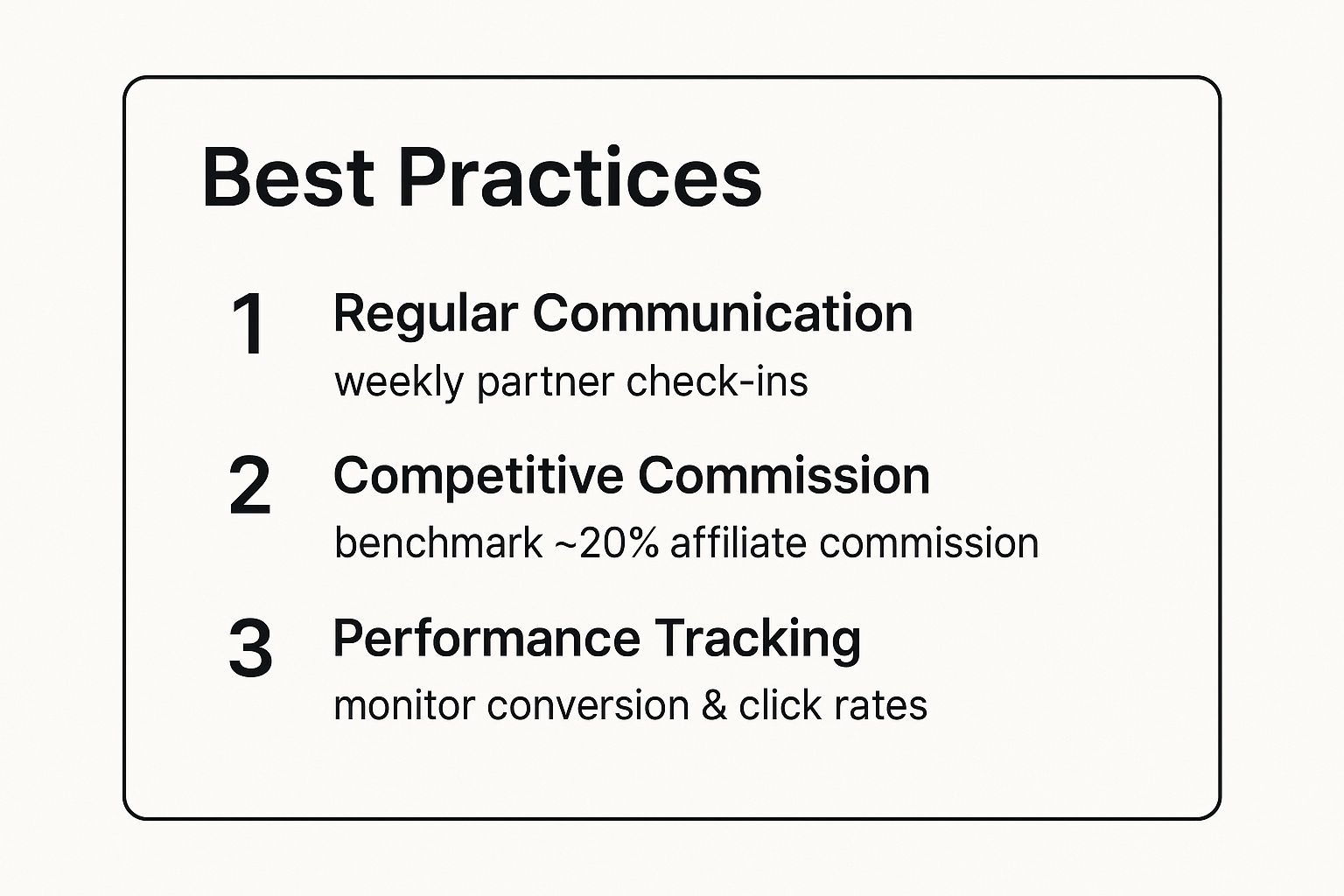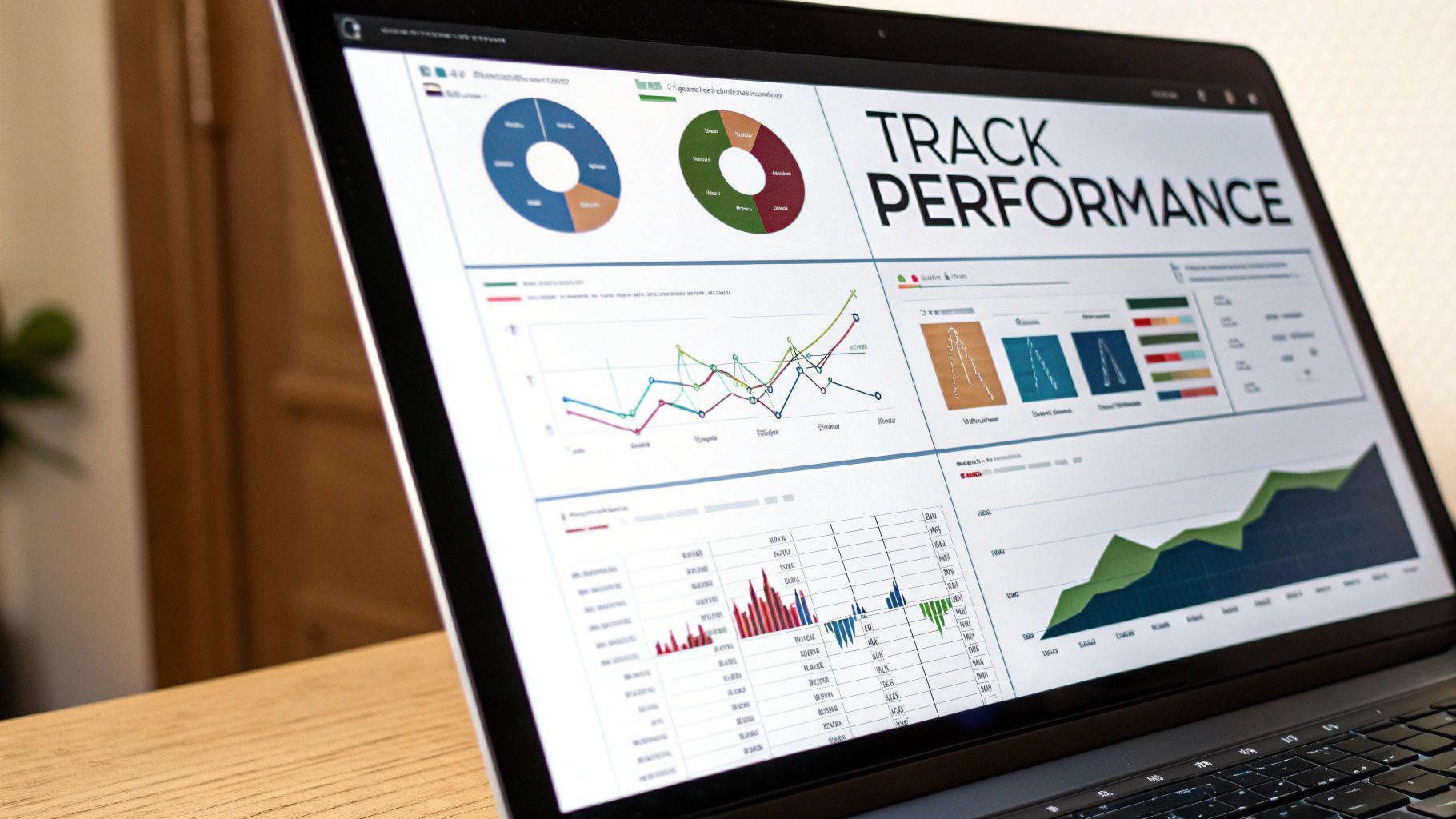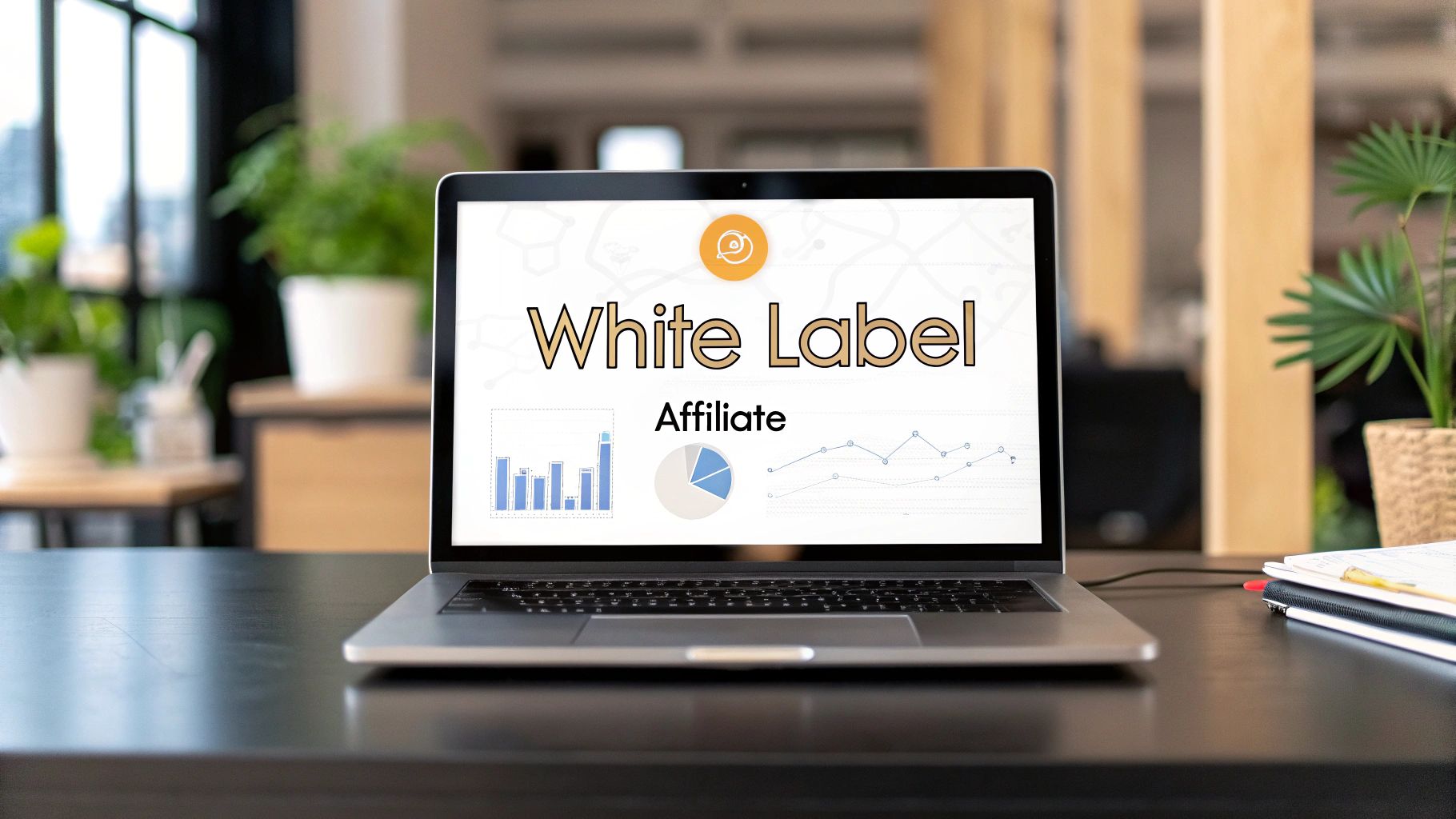Picture this: you want to launch a sophisticated, professional affiliate program for your business, but you don't have the time, budget, or engineering team to build the software from scratch. That's where a white label affiliate program comes in. In short, you're leasing powerful, ready-made technology from a specialized provider and putting your own brand name on it.
It's your program, your rules, your brand—all powered by an expert behind the scenes.
Understanding The Core Concept
The best way to think about a white label affiliate program is to compare it to a ghost kitchen. A popular restaurant might want to expand its delivery service without building new physical locations. So, they rent space in a fully equipped commercial kitchen, use their own recipes and ingredients, and send out orders in their own branded bags. The customer gets the meal they know and love, completely unaware that it was made in a shared facility.
That's exactly how this model works for your marketing. You get to run the affiliate program on your own domain, complete with your logo, colors, and branding. It feels like a natural extension of your company. But all the heavy lifting—the intricate tracking technology, the commission payouts, the security—is handled by a provider who lives and breathes this stuff. It's the fastest route to a polished, professional partner program that feels completely native to your brand.
How It Works In Practice
To really get it, you first need a solid grip on the fundamental concepts of affiliate marketing. In a typical scenario, you might send your partners to a generic, third-party affiliate network, which can feel clunky and disconnected from your brand. A white label solution completely solves that problem.
Here’s the breakdown:
- Your Branding, Their Tech: You take the provider's platform and customize everything. The affiliate dashboard, the signup forms, and all the emails get your unique look and feel.
- Seamless Partner Experience: This is a huge win. Your affiliates log into a portal that lives on your own domain (like
partners.yourcompany.com), not some random third-party site. This builds immediate trust and makes your program look far more credible. - Backend Power: While you focus on building relationships with partners, the provider is in the background managing all the technical complexities. Think cookie tracking, reliable commission calculations, and detailed reporting dashboards.
Getting this right is more important than ever. The affiliate marketing industry is on a rocket ship, expected to hit a global market size of $12 billion by 2025. Even more telling, brands that successfully merge their influencer and affiliate strategies are seeing up to a 46% increase in sales from their partners. A white label program is your ticket to professionally capturing a piece of that growth.
White Label Affiliate Program At a Glance
To bring it all together, here’s a quick summary of the moving parts and the direct benefits you get from a white label setup. This table clearly shows how each component works in your favor.
| Core Component | Your Role (The Business) | Benefit |
|---|---|---|
| Technology Platform | You lease the software from a provider. | You skip the massive cost and time sink of in-house development. |
| Brand Identity | You apply your logo, colors, and domain name. | It creates a consistent brand experience that builds partner trust. |
| Partner Management | You recruit, onboard, and manage your affiliates. | You own the direct relationship with your partners—no middleman. |
| User Experience | You offer a seamless, branded affiliate portal. | You get to market incredibly fast with a professional, ready-to-go program. |
Ultimately, this model gives you the best of both worlds: the credibility and control of an in-house solution without the headaches and high costs of building one yourself.
The Strategic Benefits for Your SaaS Business

Bringing a white label affiliate program into your business isn't just another marketing play—it's a core strategic decision that can seriously move the needle on your bottom line. For any SaaS company, where your brand's reputation and the trust you build with customers are everything, the advantages are particularly potent. This isn't just about borrowing some software; it's about hitting the growth accelerator while keeping a firm grip on your brand's story.
The first thing you'll notice is the impact on enhanced brand consistency and trust. Think about it: when a potential partner clicks to join your affiliate program, you want them to feel like they're still in your world. A white label solution makes this happen by running on your own domain, with your logo, your colors, and your voice. This gets rid of the jarring experience of being shipped off to a generic, third-party platform, which can create friction and doubt. It immediately looks more professional and shows that your partner program is an integral part of your business, not just some tacked-on afterthought.
Accelerate Your Go-to-Market Strategy
Let's be honest, building a reliable affiliate tracking and management platform from the ground up is a massive undertaking. We're talking months, maybe even years, of development time, a huge financial investment, and the headache of ongoing maintenance. A white label affiliate program lets you sidestep that entire ordeal.
Instead of pulling your valuable engineers off your main product, you can get a full-featured, professionally branded program up and running in days. That speed to market is a massive competitive edge. You can have a powerful new customer acquisition channel humming along while your competitors are still debating the specs for an in-house build. It allows you to pour your resources into what you do best—making your SaaS product even better.
Key Insight: The real magic of a white label model is the opportunity cost savings. By skipping the in-house build, you free up your best minds and your capital to focus on core product innovation and features that delight your customers. That's what truly drives long-term SaaS growth.
This smart redirection of resources has a direct impact on your financials. You avoid the massive upfront development costs, which is an immediate win for your cash flow. But more importantly, you’re setting up a performance-based marketing channel that directly lowers your Customer Acquisition Cost (CAC). You only pay affiliates when they deliver a paying customer, making your marketing budget incredibly efficient compared to the old "pay and pray" advertising models.
Attract Higher Caliber Affiliates
The best affiliates—the influencers, media buyers, and content creators with real pull—are picky about the programs they join. They're seasoned marketers who won't waste their time on a platform that looks clunky, untrustworthy, or amateurish. A program that feels off-brand is an instant turn-off.
A polished, white-labeled program signals that you're serious about partnerships. It gives these high-value partners the professional tools they expect:
- A Professional Dashboard: A clean, branded portal where they can grab their unique links, check their performance stats, and see their commissions in real-time.
- Reliable Tracking: They need to trust that every single click and conversion is tracked accurately. This confidence is non-negotiable for them to put in the effort.
- Timely Payouts: A transparent and automated payment system is crucial for building the long-term trust that keeps top partners loyal.
Of course, managing the program and these key relationships is vital. For a much deeper look at the best practices, our guide on https://refgrow.com/blog/affiliate-program-management offers a ton of actionable advice to get the most out of your efforts.
When you offer a superior partner experience, you don't just attract better affiliates; you keep them. This creates a sustainable pipeline of high-quality customers, which in turn boosts the Lifetime Value (LTV) of the users they refer. Combine this with powerful B2B SaaS content marketing strategies, and you can seriously amplify your program's reach. At the end of the day, a white label program isn't just software; it's a growth engine for building brand equity and driving scalable, profitable results.
Must-Have Features in a White Label Platform

When you're choosing a white label affiliate platform, you’re not just buying software; you're laying the groundwork for your entire partner ecosystem. Picking the right one gives you a stable, flexible foundation to build upon. The wrong one? Well, that can lead to a heap of headaches and lost opportunities down the road.
You have to look beyond the flashy sales pages and really dig into the features that will make or break your program's success. This is about giving your business the right tool to build genuine trust with partners while delivering results you can actually measure.
Let's walk through the absolute must-haves.
Deep Branding and Customization Control
The whole idea of "white label" is to make the platform feel like it’s yours, through and through. Just slapping your logo on a generic interface doesn't cut it. To look professional and build trust, you need deep control over the entire partner experience.
First and foremost, the platform must let you host the affiliate portal on your own custom domain, like partners.yourcompany.com. That’s a non-negotiable for brand credibility. Beyond that, you should be able to fully tailor the environment:
- Visual Identity: Can you change the colors, fonts, and layout to perfectly mirror your brand? You should have complete control.
- Communication: Every automated email—from welcome messages to commission alerts—needs to come from your domain and speak in your brand’s voice.
- User Interface: The affiliate dashboard has to be clean and intuitive, but also fully brandable so it feels like a natural extension of your website.
A truly white-labeled experience erases any trace of a third-party provider. It makes your affiliate program feel completely integrated with your core business.
Advanced Tracking and Attribution
Let’s be blunt: if your partners don’t trust your tracking, they won't promote you. It’s that simple. The heart of any affiliate program is its ability to accurately and reliably connect a referral to a sale.
Today’s customer journey is rarely a straight line. People click multiple links and visit a site several times before they finally convert. Your platform needs to handle that complexity without missing a beat.
Key Takeaway: The single biggest reason top affiliates leave a program is a loss of faith in the tracking. If they suspect even one sale was missed, that trust is broken—often for good. You need transparent, rock-solid tracking technology.
Look for a system that provides different ways to give credit where it's due, such as:
- First-Click Attribution: Gives credit to the affiliate who first sent the customer your way.
- Last-Click Attribution: The industry standard, rewarding the very last link a customer clicked before purchasing.
- Multi-Touch Models: More sophisticated models that can split the commission across various touchpoints in the buyer's journey.
Reliable tracking isn't just a feature; it's the foundation of trust in your white label affiliate program.
Flexible Commission Structures and Payouts
Your business isn’t cookie-cutter, so why should your commission structure be? A rigid, one-size-fits-all system that only offers a simple percentage will seriously limit your ability to motivate partners. You need flexibility.
A great platform will let you get creative with how you reward affiliates. It should support various models, including:
- Recurring Commissions: This is a must for any SaaS business. Paying affiliates for the life of the subscription is a powerful incentive.
- Tiered Commissions: This lets you automatically bump up the commission rate for your top performers when they hit certain sales goals.
- Performance Bonuses: Got a new product launching? Want to motivate affiliates to send their first 10 customers? The ability to offer one-off bonuses is key.
Just as important is how you pay them. Automated affiliate payouts are a game-changer. Manually calculating and sending payments each month is a recipe for errors and wasted time. A platform that syncs with tools like Stripe or PayPal to handle mass payouts shows partners you’re professional and reliable, which builds incredible goodwill.
This level of sophistication is a big reason the affiliate marketing industry is projected to grow from $15.7 billion in 2023 to nearly $36.9 billion by 2030. These platforms empower businesses to offer competitive commissions—often 20-70% for SaaS products—that attract the best partners. You can explore more affiliate marketing statistics to see just how much potential is out there.
Choosing Your Partnership Model: Affiliate vs. Reseller vs. Referral
When you're ready to grow your business through partnerships, you'll quickly run into a bunch of terms that sound awfully similar: affiliate, reseller, referral. It's easy to assume they're just different words for the same thing, but they’re not. Each one is a fundamentally different business model with its own rules, responsibilities, and ideal scenarios.
Picking the wrong one is like showing up to a go-kart race with a monster truck. You might have a lot of power, but you’re not set up for the track you’re on, and it’s going to get messy. To make a smart investment of your time and money, you first need to understand exactly what each partner does.
Decoding the Core Differences
At the simplest level, the main difference comes down to who does what and who "owns" the customer.
A referral partner just points someone in your direction and then steps back. An affiliate actively promotes your product to their audience. But a reseller? They take on the whole shebang, from selling the product to supporting the customer afterward.
Let's break that down a bit more to see where a white label affiliate program really fits in.
- Referral Partners: Think of these as your casual connectors. They know someone who'd be a great fit for your SaaS, so they make an introduction. Once they’ve passed the lead to your sales team, their job is pretty much done.
- Affiliate Partners: These are your outsourced marketers. They use their blog, YouTube channel, or email list to actively promote your product and send qualified traffic your way. They get a commission for every sale they drive, but they aren't involved in billing or customer support.
- Resellers: These partners are essentially an extension of your sales and support teams. They buy your product (usually at a steep discount) and sell it directly to their own customers, handling everything from billing and onboarding to front-line support.
This infographic hits on some best practices that are vital no matter which model you land on, focusing on clear communication, fair commissions, and solid tracking.

The big takeaway here is that you can’t just wing it. A successful program, regardless of type, needs a strong foundation with clear rules of engagement and incentives that actually motivate your partners.
A Detailed Partnership Comparison
To really see which path makes sense for your business, putting the models side-by-side is the best way to cut through the noise. This table breaks down the key differences in what partners do, how they make money, and how much control you keep over your brand.
Partnership Model Comparison
| Feature | White Label Affiliate Program | Reseller Program | Referral Program |
|---|---|---|---|
| Primary Role | To market and drive qualified traffic to your product. | To sell your product and manage the customer relationship. | To make introductions and provide warm leads. |
| Customer Relationship | You own the customer relationship, billing, and support. | The reseller owns the entire customer relationship. | You own the entire relationship after the introduction. |
| Revenue Model | Partners earn a commission (e.g., % of sale, recurring fee). | Resellers buy at a discount and sell at a markup. | Partners typically earn a one-time flat fee or small % of the first sale. |
| Branding Control | You maintain full brand control over the product and sales process. | The reseller often co-brands or sells under their own brand. | You maintain full brand control. |
| Ideal Use Case | Scaling customer acquisition through content creators, influencers, and media buyers. | Expanding into new markets or industries where you lack a direct sales presence. | Leveraging your existing network of customers and contacts for low-cost leads. |
The table makes it clear, but this point is so important it deserves to be highlighted.
Critical Distinction: With an affiliate program, the end-user is always your customer. With a reseller program, the end-user is the reseller's customer. This single difference has massive implications for support, billing, and long-term brand equity.
This is where the magic of a white label affiliate program comes in. You get the powerful marketing reach of a traditional affiliate model but keep the complete brand control you’d have with a direct sales approach. Your partners act as a dedicated marketing force, but your company handles all the crucial, relationship-building interactions with the customer.
This hybrid structure ensures every customer gets a consistent brand experience, allowing you to build direct, lasting relationships—which is absolutely vital for any SaaS business focused on retention and customer lifetime value. It’s how you scale growth without sacrificing control over your brand’s destiny.
How to Launch Your White Label Affiliate Program

Alright, let's move from theory to action. This is your playbook for getting a white label affiliate program off the ground and running. A successful launch isn't a one-and-done event; it's a series of smart, well-executed steps. Each stage, from initial strategy to the final rollout, builds on the last to create a program that attracts top-tier partners and drives real growth.
The real work starts long before you even look at software. You have to define what a "win" looks like for your business. Without clear objectives, you’re just flying blind.
Defining Your Goals and KPIs
Before you get caught up in features or commission rates, you need a north star. What, exactly, are you trying to accomplish with this program? Are you hoping to slash your customer acquisition costs? Break into a new market? Or are you aiming to open up an entirely new revenue stream?
Your answers will directly shape the Key Performance Indicators (KPIs) you track. Think of these as the vital signs of your program's health.
- If you’re chasing new customers: Your focus should be on KPIs like the number of new, active affiliates, the click-through rates on their links, and the total volume of new customers they bring in.
- If it’s all about revenue growth: Keep a close eye on the total revenue generated by affiliates, the average order value (AOV) from their referrals, and your overall program ROI.
- If you’re trying to expand brand reach: You’ll want to monitor metrics like impressions on affiliate content and how quickly your partner network is growing.
Nailing down these KPIs from day one gives you the clarity to measure what truly matters. It makes every future decision, from picking a platform to setting commissions, infinitely easier.
Selecting and Setting Up Your Platform
With your goals firmly in hand, you can start shopping for the right software. Use the feature checklist from the previous section as your guide, making sure any platform you consider can handle your specific needs for branding, tracking, and payments. Once you’ve made your choice, it’s time to roll up your sleeves.
This is where you bring your branded experience to life. You’ll be customizing the affiliate dashboard to match your company’s look and feel, setting up your custom domain, and getting all the technical nuts and bolts in place.
Key Takeaway: That initial setup is your one chance to make a great first impression. A clunky dashboard or confusing signup form will turn away high-quality affiliates before they even get started. Make it seamless.
A professional setup is non-negotiable, especially when you consider the industry's growth. Global spending on affiliate marketing hit $14.3 billion in 2023 and is on track for $15.7 billion in 2024, with a staggering 81% of brands now running these programs.
Equipping Your Partners for Success
Think of your affiliates as an extension of your marketing team. The better you equip them, the better they’ll perform. A world-class program doesn't just hand over a tracking link and wish them luck; it provides a full toolkit of resources designed to help them convert.
Your affiliate portal should have a resource center packed with:
- Banners and Creatives: A library of professionally designed, on-brand banners in all the standard sizes they’ll need for websites and social media.
- Email Swipes: Pre-written email templates that partners can easily copy, paste, and adapt for their own promotional campaigns.
- Product Descriptions and Talking Points: Clear, persuasive copy that spells out your product’s key benefits and sets it apart from the competition.
Providing these materials lowers the barrier to entry for new partners and helps keep your brand's messaging consistent across the board. For a deeper dive, check out our guide on how to create an affiliate program from scratch.
Recruiting Partners and Promoting the Launch
Your program is built, and the resources are ready. Now for the final push: creating buzz and recruiting your first wave of partners.
Start close to home. Personally reach out to your best customers, industry contacts, and any brand advocates you already have a relationship with. Getting an early group of enthusiastic partners on board creates powerful social proof and initial momentum. From there, you can broaden your outreach to influential bloggers, YouTubers, and content creators in your niche.
A well-planned launch sets the stage for a thriving white label program that can become a powerful growth engine for your entire business.
Common Questions About White Label Programs
https://www.youtube.com/embed/x0VKAZWUNZg
Even with all the benefits laid out, it's smart to have a few practical questions before jumping into a new growth strategy. After all, a white label affiliate program is a real investment, and you need straight answers to the things that might be on your mind.
Let's tackle those lingering questions head-on. Here are clear, no-nonsense answers to the most common queries we hear from businesses, so you have everything you need to move forward with confidence.
How Much Does a White Label Solution Cost?
This is almost always the first question, and the honest answer is: it really depends. Most providers use a few different pricing models, and figuring out which one fits you best comes down to your company's size, budget, and where you are in your growth journey.
The most straightforward model is a monthly or annual subscription fee. This gives you access to the software and all its features for a predictable flat rate, which is fantastic for budgeting. These plans usually come in tiers—the more you pay, the more you unlock, like advanced features, a higher number of affiliates, or deeper brand customization.
Another common approach is based on transaction fees. With this model, the provider takes a small slice of the commission you pay out to your affiliates. This can be really appealing when you're just starting out because the cost grows as your program succeeds. The catch? As your program scales, those small fees can start to add up in a big way. Some platforms even offer a hybrid, mixing a lower subscription fee with a small percentage of transactions.
Pro Tip: Always ask what's really included in the price. Does it cover the initial setup and onboarding? What about technical support down the line or help moving your data? Getting clarity on these details upfront will save you from surprise costs and headaches later.
Can I Migrate My Existing Affiliates?
This is a make-or-break question if you're already running an affiliate program on another platform or even a custom-built system. The short answer is yes, you can absolutely bring your existing partners over to a new white label platform. But—and this is a big but—it requires careful planning to pull it off without a hitch.
A smooth migration is non-negotiable. The last thing you want is to disrupt your partners' workflow and, more importantly, their earnings. The goal is to make the switch feel almost invisible to them. Any good white label provider will have tools and support staff to help you make this happen.
Here’s a rough idea of what the process looks like:
- Export Your Data: First, you’ll pull all of your current affiliate information—names, contact details, payment info, and their performance history.
- Import into the New System: Your new provider should offer a bulk import tool to get all that data into their platform without you having to do it one by one.
- Handle the Links: This is the most critical step. You need to make sure old tracking links don't suddenly break. The best platforms have tools that help redirect old links to the new ones, preventing lost commissions and frustrated affiliates.
Throughout this entire process, clear and constant communication with your affiliates is key. Let them know what's happening, sell them on the benefits of the new platform (like a slicker dashboard or faster payouts), and give them crystal-clear instructions on what to do.
What Level of Support Should I Expect?
The quality of customer support can be the single biggest factor in your success with a white label affiliate program. Great support isn't just a nice-to-have; it's a core feature that ensures your program gets off the ground smoothly and that any bumps in the road are fixed fast.
Think of it this way: top-tier support means the provider is more like a partner in your growth, not just a software vendor. They should offer guidance and resources that help you at every stage.
You should really expect support in three key areas:
- Onboarding and Setup: The provider needs to have your back from day one. This means dedicated help with customizing the look and feel, setting up your commission rules, and integrating the platform with your other essential tools, like your payment gateway.
- Ongoing Technical Help: When something inevitably goes sideways, you need access to quick, expert help. Look for providers who offer multiple ways to get in touch—like email, live chat, or phone—and who are transparent about their response times.
- Strategic Resources: The best providers don't just solve problems; they help you grow. This could be a knowledge base packed with guides, webinars on recruiting top affiliates, or best-practice articles to help you optimize your program for better results.
Before you sign on the dotted line, grill potential providers about their support. What are their hours? Is premium, one-on-one support an option? Their answers will tell you a lot about how much they truly care about their customers' success. It's also useful to understand how different partnership models work in the first place. You can get a better sense of this by comparing referral marketing vs. affiliate marketing and seeing how the strategies differ.
Ready to launch a fully native, brand-aligned affiliate program without the technical headaches? Refgrow makes it simple. Embed a customizable affiliate dashboard directly into your SaaS with just one line of code and connect with active affiliates instantly.

